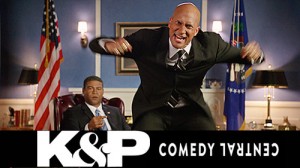VULTURE: One of Key and Peele’s most viral bits is their rapid-fire college-football-player introductions, originally inspired by New York Jets offensive lineman D’Brickashaw Ferguson. “D’Brickashaw Ferguson! What? That was it for us,” Keegan Michael Key tells us. Their first sketch, with such players as Hingle McKringleberry and Donkey Teeth, aired last season and has since gathered more than 17 million views on YouTube. Last week, they released a follow-up, and it already has 5.5 million views. The names are so perfectly crafted for maximum hilarity, but how do they come up with them? Turns out there is a crucial third collaborator on these bits, without whom they could never be written: “I enjoy writing these names with a little help from Mr. Weed,” Jordan Peele tells us. “He’s an amazing writer.” MORE
THE NEW YORKER: Key and Peele’s biracialism is central to their comedy, but in a far different way than I’d imagined: it is expansive, not constricting, a Golden Ticket to themes rarely explored on television. Like many of the best, most transgressive comics, they treat human behavior as a form of drag, shape-shifting with aggressive fluidity. It’s a school of funny that in the wrong hands can be a mean trick, as with Amos and Andy doing blackface, or Milton Berle’s ugly-woman shtick. To modern joke critics, the key distinction between a good joke and a bad one is supposed to be between “punching up” and “punching down”—taking a cheap shot at someone who is already weaker than you. But, often enough, that distinction depends on the referee: Dave Chappelle’s motive for abandoning his own Comedy Central show, after all, was in large part his discomfort with what, exactly, his white fans were laughing at. […]
For many male comics, the primal twist is putting on a dress. On the Canadian show “The Kids in the Hall,” the performers were particularly goosed whenever they got to play one  of the show’s long line of prim, defeated Toronto office girls or chain-smoking Montreal street whores. Key and Peele do play women—Peele has one fabulously manipulative female character, Meegan—but the bulk of their drag is male. They play Indian guys, Latino guys, white guys, biracial guys, mobbed-up Italians, Mexican thugs, gay fiancés, and plenty of characters whose race is beside the point. (In the première of the new season, which began last week, one of the funniest skits is an elaborate parody of “Les Misérables.”)
of the show’s long line of prim, defeated Toronto office girls or chain-smoking Montreal street whores. Key and Peele do play women—Peele has one fabulously manipulative female character, Meegan—but the bulk of their drag is male. They play Indian guys, Latino guys, white guys, biracial guys, mobbed-up Italians, Mexican thugs, gay fiancés, and plenty of characters whose race is beside the point. (In the première of the new season, which began last week, one of the funniest skits is an elaborate parody of “Les Misérables.”)
But Key and Peele’s true passion is intra-black-male drag, with scenes that explore the many ways that African-American men perform themselves: they do buppies, nerds, suits, and black Republicans. (“We’re not a monolith,” identically dressed black Republicans declare, one after another.) There is a notable manic richness in their take on thugs in prison, hip-hop performers, sports heroes, and every style of “hard” black masculinity—the characters who are freer, like the anger translator Luther, to violate every taboo. These are the roles, as they explain in an interstitial stage bit, that the comics themselves, as light-skinned, non-“street” black men, could never get cast in. When the two men tried out for the sketch show “MADtv,” they assumed they were each auditioning for the same “black guy” slot. (Eventually, both of them got roles.) The 2008 election expanded their options. “It’s hard to tell if there was a place for us on television before Obama,” Peele says, on a commentary track on the DVD of Season 1. MORE
